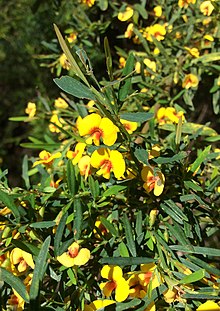| Bossiaea linophylla | |
|---|---|

| |
| Near Manjimup | |
| Scientific classification | |
| Kingdom: | Plantae |
| Clade: | Tracheophytes |
| Clade: | Angiosperms |
| Clade: | Eudicots |
| Clade: | Rosids |
| Order: | Fabales |
| Family: | Fabaceae |
| Subfamily: | Faboideae |
| Genus: | Bossiaea |
| Species: | B. linophylla |
| Binomial name | |
| Bossiaea linophylla R.Br. | |

| |
| Range map generated from data at Australasian Virtual Herbarium | |
Bossiaea linophylla is a species of flowering plant in the family Fabaceae and is endemic to the south-west of Western Australia. It is a spreading shrub with linear to oblong or egg-shaped leaves, and bright yellow to orange or apricot-coloured and red flowers.
Description
Bossiaea linophylla is a spreading shrub, usually with a weeping habit, that typically grows up to a height of up to 3 m (9.8 ft) and has branchlets that are flattened to oval in cross-section. The leaves are linear to oblong or egg-shaped, 13–30 mm (0.51–1.18 in) long and 0.9–2 mm (0.035–0.079 in) wide on a petiole up to 1 mm (0.039 in) long with tapering stipules 0.7–2.2 mm (0.028–0.087 in) long at the base. The flowers are arranged singly or in small groups, each flower on a thread-like pedicel 0.5–1.4 mm (0.020–0.055 in) long with linear bracteoles 0.7–2.2 mm (0.028–0.087 in) long on the pedicel. There is a single egg-shaped bract up to 0.5–1 mm (0.020–0.039 in) long but that falls off at the early bud stage. The five sepals are joined at the base forming a tube 2.0–3.2 mm (0.079–0.126 in) long, the two upper lobes 1.0–1.5 mm (0.039–0.059 in) long, and the lower lobes slightly shorter. The standard petal is bright yellow to orange or apricot with a red base and 6.6–9.7 mm (0.26–0.38 in) long, the wings 6.4–8.3 mm (0.25–0.33 in) long, and the keel red, sometimes with a greenish base and 4.8–6.4 mm (0.19–0.25 in) long. Flowering occurs from July to December.
Taxonomy and naming
Bossiaea linophylla was first formally described in 1812 by Robert Brown in William Aiton's Hortus Kewensis. The specific epithet (linophylla) means "thread-leaved".
Distribution and habitat
This bossiaea is found between Collie, Augusta, Albany and the Stirling Range in the Avon Wheatbelt, Esperance Plains, Jarrah Forest, Swan Coastal Plain and Warren biogeographic regions where it grows in forest, woodland and heath and is often the dominant understorey species.
Conservation status
Bossiaea linophylla is classified as "not threatened" by the Western Australian Government Department of Parks and Wildlife.
Ecology
The plant attracts moyadong, parrot subspecies Platycercus icterotis icterotis, which eat their fruit.
References
- "Bossiaea linophylla". Australian Plant Census. Retrieved 6 August 2021.
- ^ "Bossiaea linophylla". FloraBase. Western Australian Government Department of Biodiversity, Conservation and Attractions.
- ^ Ross, James H. (2006). "A conspectus of the Western Australian Bossiaea species (Bossiaeeae: Fabaceae). Muelleria 23". Muelleria. 11: 65–67. Retrieved 6 August 2021.
- "Bossiaea linophylla". APNI. Retrieved 6 August 2021.
- Brown, Robert (1812). Aiton, William (ed.). Hortus Kewensis. London: Logman, Hurst, Rees, Orme and Brown. p. 268. Retrieved 6 August 2021.
- Sharr, Francis Aubi; George, Alex (2019). Western Australian Plant Names and Their Meanings (3rd ed.). Kardinya, WA: Four Gables Press. p. 241. ISBN 9780958034180.
- Johnstone, R.E.; Storr, G.M. (1998). Taylor, Deborah (ed.). Handbook of Western Australian birds. Vol. v.1 — non passerines. Perth: Western Australian Museum. p. 300. ISBN 0730712087.